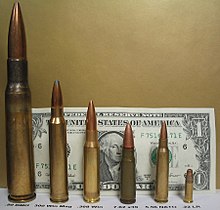50 BMG
| .50 BMG | ||||||||||||||||||||||||
|---|---|---|---|---|---|---|---|---|---|---|---|---|---|---|---|---|---|---|---|---|---|---|---|---|

|
||||||||||||||||||||||||
| Type | Machine gun/Rifle | |||||||||||||||||||||||
| Place of origin | United States | |||||||||||||||||||||||
| Service history | ||||||||||||||||||||||||
| In service | 1921–present | |||||||||||||||||||||||
| Used by | NATO and many others | |||||||||||||||||||||||
| Wars |
World War II Korean War Vietnam War Cambodian Civil War Falklands War Persian Gulf War Global War on Terrorism Iraq War War in Afghanistan Syrian Civil War Yemeni Civil War (2015-present) Saudi-led intervention in Yemen (2015-present) |
|||||||||||||||||||||||
| Production history | ||||||||||||||||||||||||
| Designer | Winchester Repeating Arms Co. and Frankford Arsenal | |||||||||||||||||||||||
| Specifications | ||||||||||||||||||||||||
| Case type | Rimless, bottleneck | |||||||||||||||||||||||
| Bullet diameter | .510 in (13.0 mm) | |||||||||||||||||||||||
| Neck diameter | .560 in (14.2 mm) | |||||||||||||||||||||||
| Shoulder diameter | .735 in (18.7 mm) | |||||||||||||||||||||||
| Base diameter | .804 in (20.4 mm) | |||||||||||||||||||||||
| Rim diameter | .804 in (20.4 mm) | |||||||||||||||||||||||
| Rim thickness | .083 in (2.1 mm) | |||||||||||||||||||||||
| Case length | 3.91 in (99 mm) | |||||||||||||||||||||||
| Overall length | 5.45 in (138 mm) | |||||||||||||||||||||||
| Case capacity | 292.8 gr H2O (18.97 cm3) | |||||||||||||||||||||||
| Primer type | #35 Arsenal Primer | |||||||||||||||||||||||
| Maximum pressure (TM43-0001-27) | 54,923 psi (378.68 MPa) | |||||||||||||||||||||||
| Maximum pressure (EPVAT) | 60,481 psi (417.00 MPa) | |||||||||||||||||||||||
| Maximum pressure (C.I.P.) | 53,664 psi (370.00 MPa) | |||||||||||||||||||||||
| Ballistic performance | ||||||||||||||||||||||||
|
||||||||||||||||||||||||
|
Test barrel length: 45 in (1,100 mm) Source(s): Ammoguide.com |
||||||||||||||||||||||||
The .50 Browning Machine Gun (.50 BMG, 12.7×99mm NATO and designated as the 50 Browning by the C.I.P.) is a cartridge developed for the Browning .50 caliber machine gun in the late 1910s. Entering service officially in 1921, the round is based on a greatly scaled-up .30-06 cartridge. Under STANAG 4383, it is a standard cartridge for NATO forces as well as many non-NATO countries. The cartridge itself has been made in many variants: multiple generations of regular ball, tracer, armor-piercing (AP), incendiary, and saboted sub-caliber rounds. The rounds intended for machine guns are linked using metallic links.
The .50 BMG cartridge is also used in long-range target and anti-materiel rifles, as well as other .50-caliber machine guns.
A wide variety of ammunition is available, and the availability of match grade ammunition has increased the usefulness of .50 caliber rifles by allowing more accurate fire than lower quality rounds.
John Browning had the idea for this round during World War I in response to a need for an anti-aircraft weapon, based on a scaled-up .30-06 Springfield design, used in a machine gun based on a scaled-up M1919/M1917 design that Browning had initially developed around 1900 (but which was not adopted by the U.S. military until 1917, hence the model designation). Armor-piercing incendiary tracer (APIT) rounds were especially effective against aircraft, and the AP rounds and armor-piercing incendiary (API) rounds were excellent for destroying concrete bunkers, structures, and lighter AFVs. The API and APIT rounds left a flash, report, and smoke on contact, useful in detecting strikes on enemy targets.
...
Wikipedia
